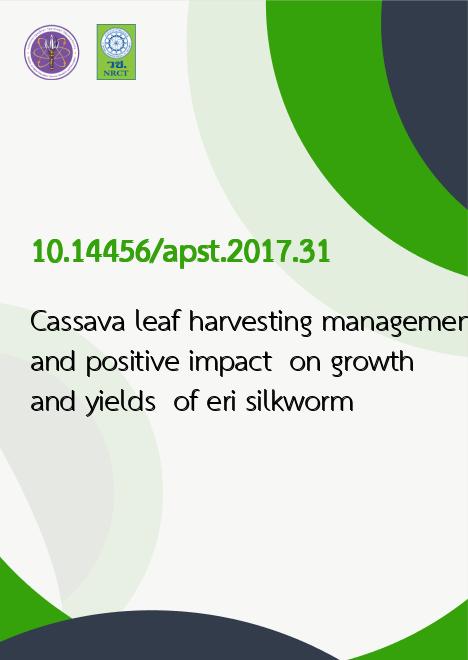
|
Cassava leaf harvesting management and positive impact on growth and yields of eri silkworm |
|---|---|
| รหัสดีโอไอ | |
| Creator | Sivilai Sirimungkararat |
| Title | Cassava leaf harvesting management and positive impact on growth and yields of eri silkworm |
| Contributor | Chanapat Buamuangphia, Weerasak Saksirirat,KarintornSrijankam |
| Publisher | Research and Technology Transfer Affairs Division.Khon Kaen University. |
| Publication Year | 2560 |
| Journal Title | Asia-Pacific Journal of Science and Technology (APST) |
| Journal Vol. | 22 |
| Journal No. | 4 |
| Page no. | 1-11 |
| Keyword | Cassava, eri silkworm, leaf management, extension variety, rearing |
| URL Website | https://tci-thaijo.org/index.php/APST/index |
| Website title | https://tci-thaijo.org/index.php/APST/article/view/108011 |
| ISSN | 2539-6293 |
| Abstract | Cassava is one of the major host plants for eri silkworm rearing especially in Thailand. The representative for extension and popular varieties, Kasetsart 50 (KU50) and Rayong 11, were experimented in field on effect of cassava leaf harvest management and rearing eri silkworm. Cassava leaves were harvested 3 times (batches) when cassava aged6, 8 and 10 months. Each time, leaves were harvested 30% of total per plant with 2 methods; harvest every day and every other day. The experimentwas conducted using randomized complete block design (RCBD) comprised 4 treatments and 3 replications with 10 plants/replication. It was found that average of Rayong 11 cassava leaves, harvested every other day (68,534.40 leaves/rai) was higher than KU50 (45,758.40 leaves/rai). Also for harvested every day, Rayong 11 (63,883.20 leaves/rai) still had more than KU50 (52,195.20 leaves/rai). The harvested leaves were used as food plant for eri silkworm rearing of 3 batches according to 3 times of leaf harvesting. The life cycle (eggadult) of all batches fed with KU50 and Rayong 11 were similar (between 4168 days). Survival of larval stage (1st5thinstar) and larva (1st5thinstar) adult for the 1stand 2ndbatch, Rayong 11 were higher but not significantly different toKU50. Whereas in 3rdbatch, KU50 expressed maximum survival percentage of 1st5thinstar (91%) and not significant difference tofeeding with Rayong 11 (89.33%). For larva (1st5thinstar) adult, KU50 still gave the higher survival rate (75%) and significantly different (P<0.05) to Rayong 11 (60%). In the case of average of cocoon and egg yields; the 1stbatch, all cocoon yields obtained from feeding with KU50 were the highest values. Only fresh cocoon weight, pupa weight, shell weight and total shell weight were significantly different (P<0.05) compared to Rayong 11. For egg yields; Rayong 11 exhibited all average yields higher than KU50and not significant difference. For 2ndbatch, all cocoon yields were similar as feeding with both cassava varieties and not significantly different. However, feeding with KU50 derived higher cocoon yields in 3 values; fresh cocoon weight (2.0563 g), pupa weight (1.7650 g) and fresh cocoon weight/10,000 larvae (18.85 kg). While feeding with Rayong 11 gave higher yields of shell weight (0.2830 g), %shell (14.02%) and total shell weight (26.04 g). Moreover, Rayong 11 fed to eri silkworms expressed all higher values with statistical difference (P<0.05) on total eggs and total hatchability against feeding with KU50. In 3rdbatch, cocoon yields obtained from KU50 were higher only fresh cocoon weight (2.1980 g), pupa weight (1.9156 g) and fresh cocoon weight/10,000 larvae (20 kg). When feeding with Rayong 11 the highest yields were shell weight (0.2870 g), %shell (13.13%) and total shell weight (25.63 g). And egg yields, feeding with KU50 gave all yields higher; total eggs and total hatchability were significantly different (P<0.05), compared to feeding with Rayong 11. The results of this research reveal especially method, frequency, timing and variety for cassava leaf harvesting management is very useful in order to gain more benefit for cassava plantation and eri silkworm rearing as a whole. |